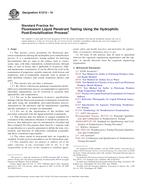Potrebujeme váš súhlas na využitie jednotlivých dát, aby sa vám okrem iného mohli ukazovať informácie týkajúce sa vašich záujmov. Súhlas udelíte kliknutím na tlačidlo „OK“.
ASTM E1000-98(2009)
Standard Guide for Radioscopy
Automaticky preložený názov:
Štandardné Sprievodca pre Radioscopy
NORMA vydaná dňa 1.6.2009
Informácie o norme:
Označenie normy: ASTM E1000-98(2009)
Poznámka: NEPLATNÁ
Dátum vydania normy: 1.6.2009
Kód tovaru: NS-40087
Počet strán: 20
Približná hmotnosť: 60 g (0.13 libier)
Krajina: Americká technická norma
Kategória: Technické normy ASTM
Kategórie - podobné normy:
Anotácia textu normy ASTM E1000-98(2009) :
Keywords:
configuration, electronic, module, non-destructive, radioscopy, real-time, Aluminum, Components analysis, Defects, Electrical conductors (semiconductors), Gamma radiation, Light transmission and reflection, Metals and metallic materials, Nonfilm detection, Performance--laboratory instrumentation/process, Radiation exposure, Radioscopic examination, Spectral data, Steel, Structural analysis/applications, X-irradiation, ICS Number Code 19.100 (Non-destructive testing)
Doplňujúce informácie
| Significance and Use | ||||||||||||||||||||||
|
Radioscopy is a versatile nondestructive means for examining an object. It provides immediate information regarding the nature, size, location, and distribution of imperfections, both internal and external. It also provides a rapid check of the dimensions, mechanical configuration, and the presence and positioning of components in a mechanism. It indicates in real-time the presence of structural or component imperfections anywhere in a mechanism or an assembly. Through manipulation, it may provide three-dimensional information regarding the nature, sizes, and relative positioning of items of interest within an object, and can be further employed to check the functioning of internal mechanisms. Radioscopy permits timely assessments of product integrity, and allows prompt disposition of the product based on acceptance standards. Although closely related to the radiographic method, it has much lower operating costs in terms of time, manpower, and material. Long-term records of the radioscopic image may be obtained through motion-picture recording (cinefluorography), video recording, or “still” photographs using conventional cameras. The radioscopic image may be electronically enhanced, digitized, or otherwise processed for improved visual image analysis or automatic, computer-aided analysis, or both. |
||||||||||||||||||||||
| 1. Scope | ||||||||||||||||||||||
|
1.1 This guide is for tutorial purposes only and to outline the general principles of radioscopic imaging. 1.2 This guide describes practices and image quality measuring systems for real-time, and near real-time, nonfilm detection, display, and recording of radioscopic images. These images, used in materials examination, are generated by penetrating radiation passing through the subject material and producing an image on the detecting medium. Although the described radiation sources are specifically X-ray and gamma-ray, the general concepts can be used for other radiation sources such as neutrons. The image detection and display techniques are nonfilm, but the use of photographic film as a means for permanent recording of the image is not precluded. Note 1—For information purposes, refer to Terminology E 1316. 1.3 This standard does not purport to address all of the safety concerns, if any, associated with its use. It is the responsibility of the user of this standard to establish appropriate safety and health practices and determine the applicability of regulatory limitations prior to use. For specific safety precautionary statements, see Section 6. |
||||||||||||||||||||||
| 2. Referenced Documents | ||||||||||||||||||||||
|
Podobné normy:
Historická
15.2.2010
Historická
15.2.2010
Historická
1.1.2005
Historická
15.2.2010
Historická
1.12.2013
Historická
1.6.2014
Odporúčame:
Aktualizácia technických noriem
Chcete mať istotu, že používate len platné technické normy?
Ponúkame Vám riešenie, ktoré Vám zaistí mesačný prehľad o aktuálnosti noriem, ktoré používate.
Chcete vedieť viac informácií ? Pozrite sa na túto stránku.



 ASTM E1209-10
ASTM E1209-10 ASTM E1210-10
ASTM E1210-10 ASTM E1219-10
ASTM E1219-10 ASTM E1220-10
ASTM E1220-10 ASTM E1254-13
ASTM E1254-13 ASTM E1316-14
ASTM E1316-14
 Cookies
Cookies
